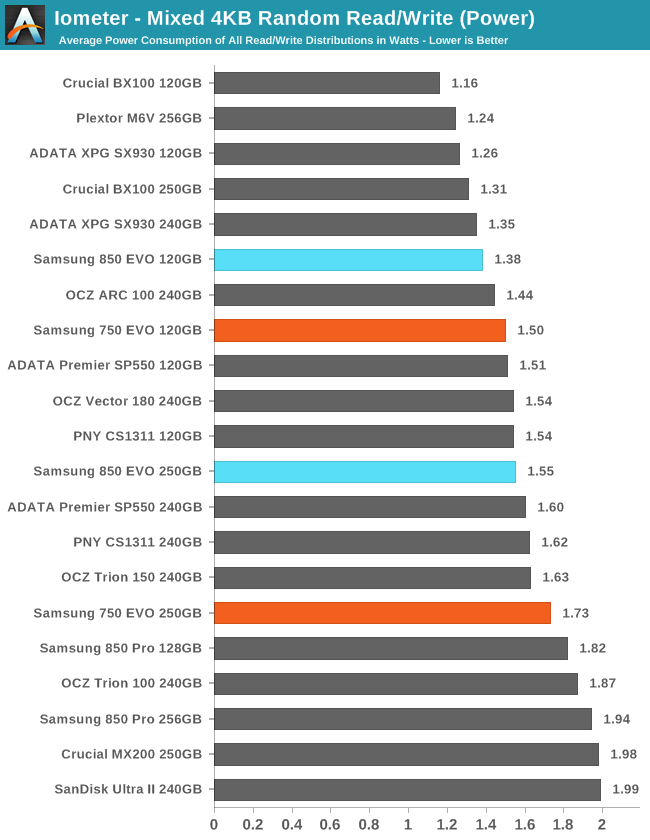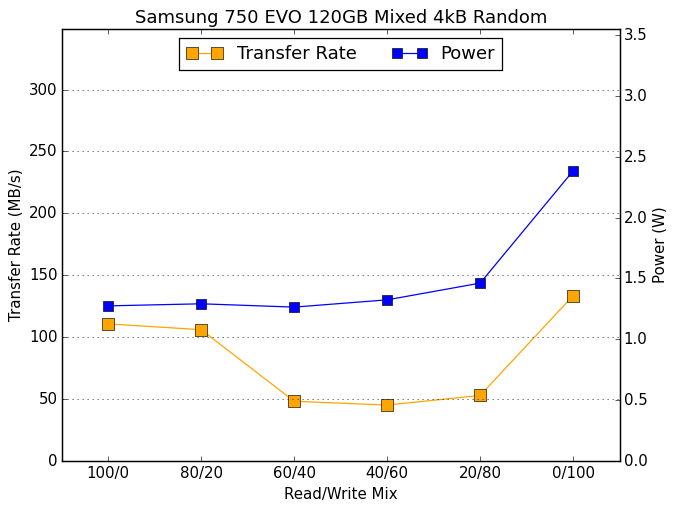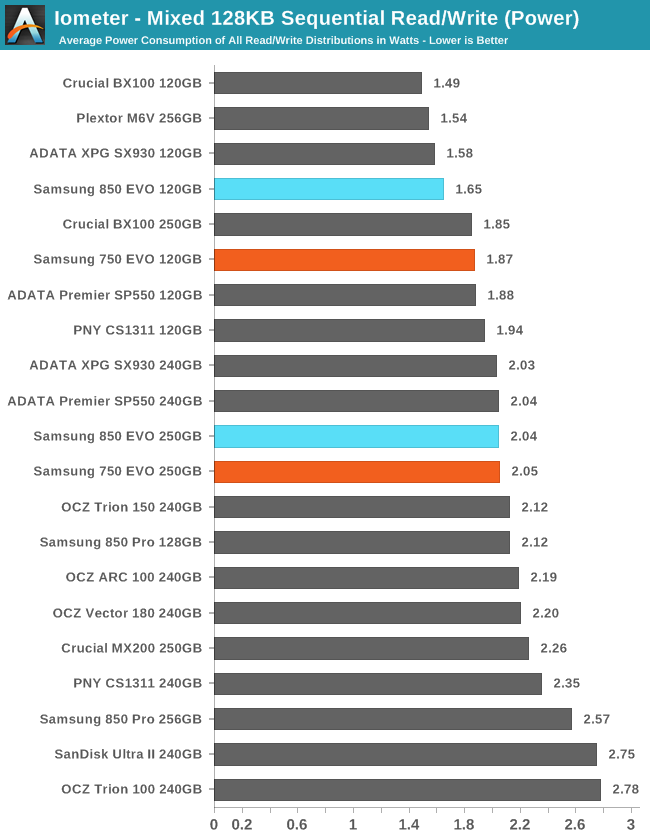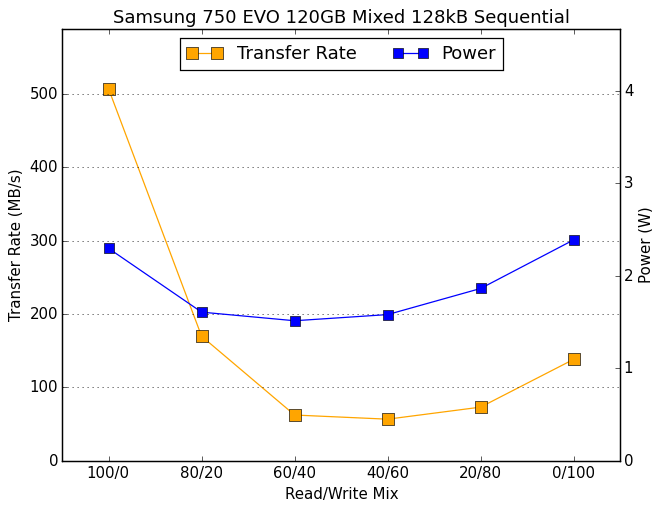The Samsung 750 EVO (120GB & 250GB) SSD Review: A Return To Planar NAND
by Billy Tallis on April 22, 2016 8:00 AM ESTMixed Random Read/Write Performance
The mixed random I/O benchmark starts with a pure read test and gradually increases the proportion of writes, finishing with pure writes. The queue depth is 3 for the entire test and each subtest lasts for 3 minutes, for a total test duration of 18 minutes. As with the pure random write test, this test is restricted to a 16GB span of the drive, which is empty save for the 16GB test file.

The 750 EVO outperforms any non-Samsung drive of similar capacity on the mixed random I/O test, and the 120GB 750 EVO even beats a few MLC drives with twice the capacity.

The 750 EVO has above-average power efficiency during the mixed random I/O test.
 |
|||||||||
Most drives lose performance during the middle phases of the mixed random I/O test. High performance scores on this test rely on performance bouncing back during the final phase of the test when the workload shifts to pure writes. The 750 EVO's spike at the end is noticeable though not huge, but it also benefits from comparatively good performance in the first two sub-tests.
Mixed Sequential Read/Write Performance
The mixed sequential access test covers the entire span of the drive and uses a queue depth of one. It starts with a pure read test and gradually increases the proportion of writes, finishing with pure writes. Each subtest lasts for 3 minutes, for a total test duration of 18 minutes. The drive is filled before the test starts.

Unlike for the mixed random I/O test, most MLC drives are able to maintain a clear performance lead over the planar TLC drives—including the 750 EVO.

The 750 EVO's power consumption is low enough that it is clearly the most efficient planar TLC drive, but its efficiency doesn't beat a typical MLC drive.
 |
|||||||||
The 750 EVO has great read speed, but it bottoms out at a relatively low level during the middle of the test and doesn't bounce back at the end as much as most MLC drives and the 850 EVO.










109 Comments
View All Comments
Shadow7037932 - Friday, April 22, 2016 - link
The prices aren't competitive. The Ultra II in particular tends to go on sale rather often for around $50.Shadow7037932 - Friday, April 22, 2016 - link
Also, if it's anything like the price drop we saw with the 850 EVOs, this could drop down to ~$50 or so in a few months I think.barleyguy - Friday, April 22, 2016 - link
This drive hasn't been out long enough to know what price it will go on sale for. So I consider any comments on pricing pretty irrelevant.Outside of that, there are only 3 brands of SSD I trust my data to, which is Intel, Crucial/Micron, and Samsung. I'll pay more for those 3 brands than I will other brands, because of reliability.
AkulaClass - Friday, April 22, 2016 - link
As 250GB low cost I would grab a SanDisk Ultra II.barleyguy - Friday, April 22, 2016 - link
8 of the 48 reviews of that drive on NewEgg are "worked great until it died in a month and I lost my data". As I said in another post, Intel, Crucial, and Samsung are IMO on a different tier of reliability than everybody else.Shadow7037932 - Saturday, April 23, 2016 - link
I like how you're saying Samsung there without considering the issues they've had with the 840. Out of all three you mentioned, only Intel has had solid SSDs since the first gen.barleyguy - Saturday, April 23, 2016 - link
I actually own an 840 Evo in my daughter's laptop. The issues with it never involved data loss or "early death", only degraded performance. Even in its degraded performance mode it still feels faster than a hard drive. And the patches they issued to "fix" it work pretty well to restore it back to SSD-like performance.So, in short, I still trust Samsung on the SSD front way more than Sandisk.
Though I don't disagree that Intel makes excellent SSDs. They're the way to go for a "critical main desktop" type application.
andrewaggb - Sunday, April 24, 2016 - link
I was going to say that as well. I have an 840 evo in my machine and I haven't lost any data. I regret purchasing it... but it works. The only SSD I've had die so far was a Kingston V100. Still have a couple intel 320 series ssd's running strong, a couple sandisk ones (don't recall the model numbers) that are working and a crucial M500 that is working.Dwedit - Sunday, April 24, 2016 - link
I had the old Intel X25-M, and it had a catastrophic failure where the disk name changed to "BAD CONTEXT" and size changed to 8MB.K_Space - Wednesday, April 27, 2016 - link
X25-M (version 2) still going strong here just not as a main drive since 80Gb is puny. I have both SD Ultra II (960Gb) and 2x Extreme Pro (480Gb) going with no problems. The Extreme Pro was purchased straight after Anadtech glowing review particularly with its 10 years warranty. Not sure what the warranty is for the Ultra II but wouldn't be surprised if its 5+. For every review that says: my SSD died, you'll get a "my SSD is alive & well" so take em with a pinch of salt. It all depends on usage scenario and user expertise and we know how variable that can be.